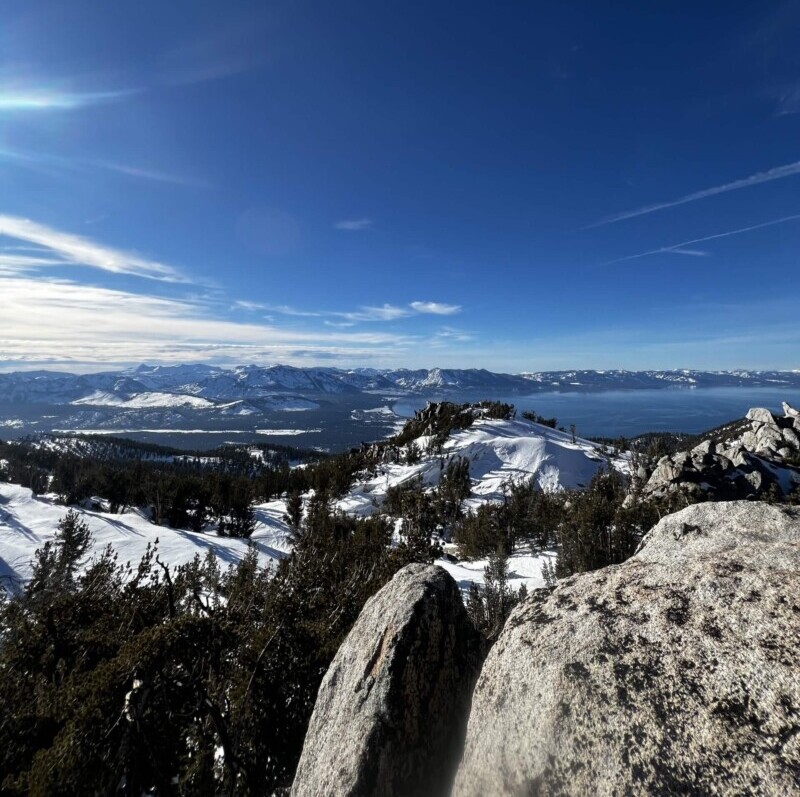Jamie Hinrichs, Public Affairs Specialist – Pacific Southwest Regional Office
Rumor has it that outdoor recreation and species conservation are at odds. Outdoor activities and infrastructure are often typecast as an inevitable threat to forest flora and fauna. However, a collaboration between the Forest Service and a destination ski resort is turning that stereotype on its head to protect a keystone tree — the whitebark pine.
Heavenly Mountain Resort (Heavenly) spans the California-Nevada border in South Lake Tahoe. With 7,050 acres of national forest land on the Lake Tahoe Basin Management Unit (LTBMU) and the Humboldt –Toiyabe National Forest, it operates under a special use permit. In many ways, this permit fosters a unique relationship between the Forest Service and the resort, one which also has significant benefits for the local economy. Ski areas on national forest lands, like Heavenly, support about 64,000 full- and part-time jobs and contributed about $1.8 billion in 2021-2022 to the state’s gross domestic product.
Equally important is the access to outdoor activities mountain resorts provide on national forests. At Heavenly that includes downhill skiing, snowboarding, snowbiking, tubing, and more. Heavenly and the Forest Service also collaborate on public programming that blends recreation with conservation education. Winter Trek bundles fifth graders onto a gondola to snowshoe at 9,100 feet and learn about water conservation, land stewardship, and fire and forest ecology of the Lake Tahoe Basin. And the Ski with a Ranger program offers free guided tours to the public where they learn about environmental stewardship and the role of the Forest Service in ski areas.
“Although there is high visitation in this concentrated area, the Forest Service and Heavenly work together to provide recreational enjoyment while also protecting sensitive species,” said Cecilia Reed, Mountain Resorts Manager on the LTBMU and Eldorado National Forest. The ongoing, collaborative efforts to protect the whitebark pine illustrates the symbiosis of those two goals.
The whitebark pine is a common sight at Heavenly, even if many visitors don’t know it by name. Adapted to the gusts and freeze of high elevations, it often has a windswept appearance, suggesting motion in its stillness.
So why should we protect the whitebark pine? It’s a keystone species — one that other species in an ecosystem depend on. The whitebark provides food and habitat for wildlife, especially the Clark’s nutcracker. This jay-sized bird relies on the seeds, and in turn helps disperse the seed for natural regeneration.
“The whitebark pine also contributes to the scenic quality of Heavenly Mountain Resort,” said Emma Williams, Forest Botanist on the LTBMU. “You can see them as you’re riding up the lifts. They have a very unique structure — multi stemmed, short and stocky and grow in these clusters. At those higher elevations, visitors really like to weave in and out of trees. So whitebark pines offer that experience.”
But this tree is in trouble. As of December 2022, the U.S. Fish and Wildlife Service officially recognized the whitebark pine as a threatened species under the Endangered Species Act of 1973. A series of interconnected stressors have contributed to its decline.
“Mountain pine beetle outbreaks and white pine blister — a lethal non-native fungus — are two of the major threats to this species across its range,” said Williams. “Additionally, drought, climate change, and altered fire regimes are impacting the health of forests in the west, and whitebark pines share that vulnerability.”
Although the official listing of the whitebark pine as a threatened species is new, the desire to protect this species is not. Heavenly and the LTBMU have been collaborating on management of the whitebark pine for years as the species was identified as a candidate for listing by U.S. Fish and Wildlife Service in 2011 and the Pacific Southwest Region of the Forest Service identified it as a Forest Service sensitive species in 2013. Efforts include surveys and mapping to locate where dominant populations are growing and review of recreation projects to mitigate impacts to the species.
“We have a healthy population up here,” said Blair Davidson, Senior Analyst for Mountain Planning at Heavenly Mountain Resort. “Together with the Forest Service, the team here at Heavenly is actively working to do more in service of helping this species thrive.”
Heavenly and the Forest Service also developed an initial whitebark pine management action plan in 2018. Now that the species has been listed as threatened, the Forest Service and Heavenly will work with the U.S. Fish and Wildlife Service to expand and enhance local populations of this iconic species.
At Heavenly and within the LTBMU, this tree is a keystone tree of recreation too. Through its entanglement with both the beauty and motions of snow activities, we are reminded that protection and play go hand-in-hand on national forest lands.


